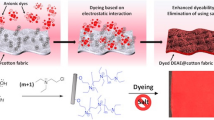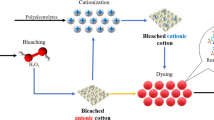Summary
The streaming potentials are measured at the interface between cotton chemisorbed with different crosslinking agents and different electrolyte solutions. Data were obtained as a function of concentration of electrolytes.
The zeta potentials are found to decrease with increasing electrolyte concentration. The rate of change of zeta potential is much smaller than the theoretical values calculated from the different models of double layer. The discrepancy between the observed and theoretical values has been discussed.
The surface charge density,σ, on cotton at the interface has been calculated and found to increase with the electrolyte concentration. This functional relationship betweenσ -C is explained from the consideration of the modification of the structure of water in the vicinity of the ion. The increase in surface charge density with the increase in electrolyte concentration is in the order KCl> NaI> NaBr> NaCl which is in the structure breaking capacity.
Zusammenfassung
Das Strömungspotential an den Grenzflächen der aus mit verschiedenen Vernetzungsmitteln chemisorbierter Baumwolle und verschiedenen elektrolytischen Lösungen entstehenden Systeme wurde in Abhängigkeit von der Konzentration der Elektrolyten bestimmt.
Es wurde festgestellt, daß die Zeta-Potentiale mit zunehmender Konzentration der Elektrolyte abfallen. Die Abnahme der Zeta-Potentiale war viel kleiner als der aus verschiedenen Doppelschichtmodellen theoretisch errechnete Wert. Die Ursachen dieses Unterschiedes zwischen beobachteten und berechneten Werten wurden erläutert.
Die Flächenladungsdichte (σ) für Baumwolle an der Grenzfläche nimmt mit zunehmender Elektrolytkonzentration (C) zu. Die funktionelle Beziehung zwischenσ undC wurde auf der Basis der Modifikation des in Ionennähe befindlichen Wassers erklärt. Die Erhöhung der Flächenladungsdichte mit zunehmender Elektrolytkonzentration wächst in der Reihenfolge KCl > NaI > NaBr > NaCl, was mit der Strukturbruchfähigkeit der Ionen übereinstimmt.
Similar content being viewed by others
References
Jacobasch, H. J., Faserforschung und Textiltechnik20, No. 4, 191 (1969).
Suzawa, T. andN. Kitagasva, Kogyo Kagaku Zasshi73, No. 8 1858 (1970).
Suzawa, T. andT. Mukai, Kogyo Kagaku Zasshi73, No. 11, 2451 (1970).
Suzawa, T., K. Nagareda andY. Mizubiro, Sen-i Gakkaishi27, No. 3, 108 (1971).
Giles, C. H. andA. P. D'Silva, Trans. Faraday Soc.65, 2516 (1969).
Lokbande, H. T., V. F. Androsov andE. N. Golovanov, Ind. J. Tech.8, 89, 92 (1970).
Lokhande, H. T., Colourage, Annual 11 (1970).
Androsov, V. F., V. S. Bondavenko, K. I. Andreeva and I. D. Tugai, Tech. Tex. Ind. U. S. S. R., No. 2, 95 (1970).
Bondarenko, V. S., V. F. Androsov, L. A. Tugushib and V. M. Kurbatova, Tech. Tex. Ind. U.S.S.R., No. 4, 76 (1970).
Bondarenko, V. S., V. F. Androsov, L. A. Tugusbi andV. M. Kurbatova, Technologiya Tekstil noi Promyshlennosti, No. 4 (77), 74 (1970).
Madan, G. L., S. K. Sbrivastava andN. T. Baddi, Kolloid-Z. u. Z. Polymere251, 483 (1973).
Iyer, S. R. S. andR. Jayaram, J. S. D. C.87, 338 (1971).
Madan, G. L. andS. B. Patel, Textile Res. J. (communicated).
Schulman, J. H. andH. C. Parreiva, in: Solid Surfaces and Gassolid Interface, Advances in Chemistry Series, p. 160, No. 33 (1961).
Robinson, L. B., J. Chem. Phys.14, 721 (1946);15, 113 (1947).
Eversole, W. G. andW. W. Boardman, J. Chem. Phys.9, 798 (1941).
Benton, D. P. andG. A. B. Elton, 2nd Intl. Congress on Surface Activity, Proc. (London)3, 28 (1957).
Hunter, R. J. andH. J. L. Wright, J. Colloid Interface Sci.37, 564 (1971).
Madan, G. L. andS. K. Shrivastava, Kolloid-Z. u. Z. Polymere (in press).
Overbeck, J. Tb. G. in: Colloid Sci. ed.H. R. Kruyt, Vol. 1, p. 229 (London, 1952).
Frank, H. S. andW. Y. Wen, Dis. Faraday Soc.24, 133 (1957).
Neale, S. M. andJ. Farrar, J. Colloid Sci.7, 186 (1952).
Author information
Authors and Affiliations
Rights and permissions
About this article
Cite this article
Madan, G.L., Shrivastava, S.K. Electrokinetic studies of cotton. Part IV.: Role of water in influencing surface charge density of cotton in electrolyte solution. Colloid & Polymer Sci 255, 269–275 (1977). https://doi.org/10.1007/BF01381286
Received:
Issue Date:
DOI: https://doi.org/10.1007/BF01381286




